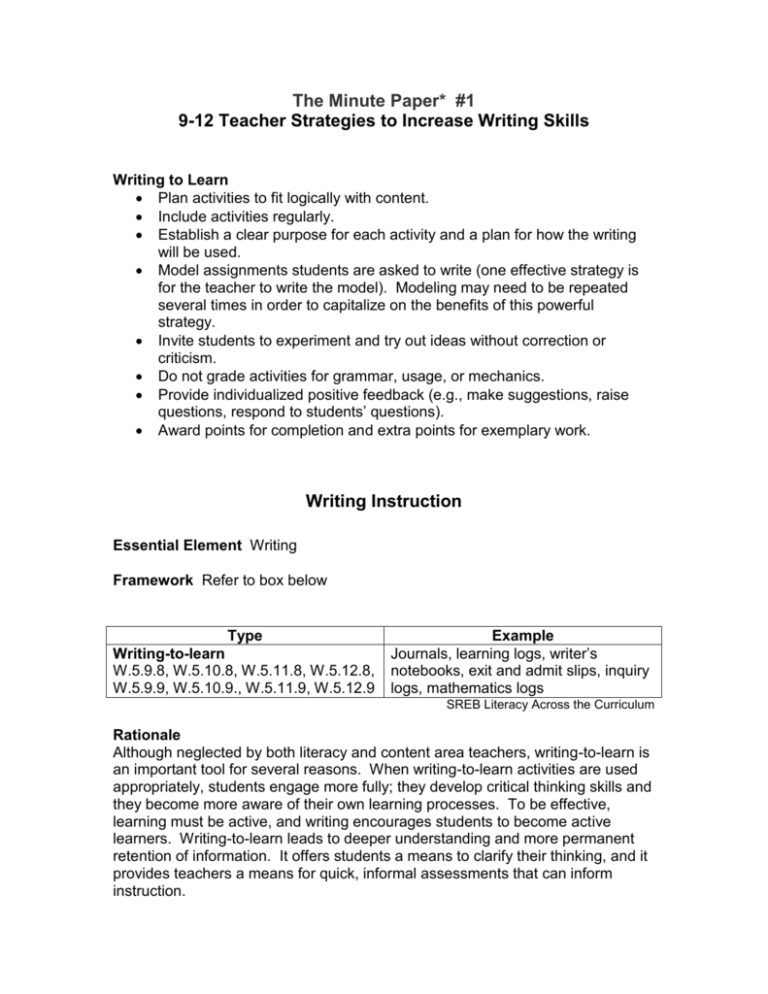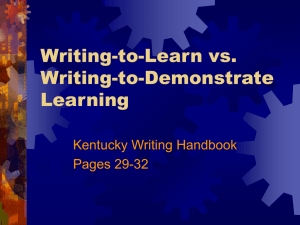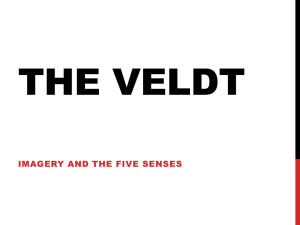
The Minute Paper* #1
9-12 Teacher Strategies to Increase Writing Skills
Writing to Learn
Plan activities to fit logically with content.
Include activities regularly.
Establish a clear purpose for each activity and a plan for how the writing
will be used.
Model assignments students are asked to write (one effective strategy is
for the teacher to write the model). Modeling may need to be repeated
several times in order to capitalize on the benefits of this powerful
strategy.
Invite students to experiment and try out ideas without correction or
criticism.
Do not grade activities for grammar, usage, or mechanics.
Provide individualized positive feedback (e.g., make suggestions, raise
questions, respond to students’ questions).
Award points for completion and extra points for exemplary work.
Writing Instruction
Essential Element Writing
Framework Refer to box below
Type
Writing-to-learn
W.5.9.8, W.5.10.8, W.5.11.8, W.5.12.8,
W.5.9.9, W.5.10.9., W.5.11.9, W.5.12.9
Example
Journals, learning logs, writer’s
notebooks, exit and admit slips, inquiry
logs, mathematics logs
SREB Literacy Across the Curriculum
Rationale
Although neglected by both literacy and content area teachers, writing-to-learn is
an important tool for several reasons. When writing-to-learn activities are used
appropriately, students engage more fully; they develop critical thinking skills and
they become more aware of their own learning processes. To be effective,
learning must be active, and writing encourages students to become active
learners. Writing-to-learn leads to deeper understanding and more permanent
retention of information. It offers students a means to clarify their thinking, and it
provides teachers a means for quick, informal assessments that can inform
instruction.
Note: In order to meet the needs of diverse learners less complex materials can
be employed to accommodate the needs of Tiers II through V students. (See
‘Strategies for Teaching Writing Skills to Tier III, IV, & V Students’). It should not
be assumed that students who struggle with writing cannot use adapted
materials with the graphic organizers and other ideas presented here.
Writing-to-learn activities are immense in variety and can be used effectively at
the beginning, middle, and/or end of a lesson or unit of study. Because they are
often short and can be quickly assessed, teachers are able to provide immediate
personal and positive feedback. These activities also encourage frequent use,
and writing frequently is more beneficial to learning than traditional long writing
assignments given infrequently. When writing-to-learn activities are assessed
without consideration of grammatical or mechanical concerns, students develop
greater fluency and are more willing to take risks and experiment with new ideas.
The purpose of this kind of writing is for students to capture ideas and to connect
personally with what they read and study.
Materials
Short pieces of engaging text, informational or narrative. Tiers II through V
students may need a tape recorded version of the text. Note: In several
of the activities which follow, sample pieces of text have been included.
Writing-to-learn activities should be designed for use with the whole class
or with small groups. These activities may be implemented at the
beginning, middle, and/or end of instruction; some require as little as two
or three minutes; others may take more time, depending on how much of
the writing process is included. Writing-to-learn activities may usually be
assessed as rough drafts, but several may become the basis of more
extensive alternative assessment. Teachers can easily determine when
to introduce revising, editing, and publishing. All of the following activities
can be found in Tools for Teaching Content Literacy by Janet Allen or in
Smart Step/Next Step Strategies for the Content Areas produced by the
Arkansas Department of Education.
Direct Instruction
The teacher will explain and give examples of how writing helps students
to clarify their thinking and remember what they have learned (grocery
lists, e-mails, text messages, memos, class notes, etc.). S/he will
emphasize that writing helps learners become more active and allows
them to take more responsibility for their own learning. The teacher will
explain how writing-to-learn allows the student to discover, organize and
retrieve information more effectively and will illustrate a variety of tools that
can be used for writing-to-learn (journals, learning logs, graphic
organizers, etc.)
Modeling
Many of the writing-to-learn activities that follow include samples of text,
graphic organizers, and possible responses that can be used to model the
strategy. Regardless of whether the activity is very short or more involved,
the teacher should work through the activity so that students understand what
quality responses should look like. Thinking should be made visible on chart
paper, at the board or on the overhead projector. In some cases, the teacher
should model the strategy several times with different pieces of short text.
Guided Practice
All of the writing-to-learn activities that follow allow students to practice what
they have seen the teacher model. These activities encourage frequent
writing, with the student rather than the teacher as the audience. Most can be
done collaboratively or independently; all require teacher feedback so that
students perceive the benefit and continue to engage fully. These guided
practices afford the teacher the opportunity to assess understanding quickly
without the necessity of evaluating grammar and mechanics.
Application
Several of these activities lend themselves to more fully developed writing
assignments that afford the opportunity for creative expression. As students
become more secure with these strategies, they may then be able to design
their own assignments. For example, when students initially use the RAFT
activity, the teacher must supply the role, the audience, the format and the
theme choices. As they become more confident, students may be able to
originate their own options. Also, many of the strategies invite more
extensive development through the writing process; what started as a quick
response to learning may become a fully developed writing assignment that
includes all aspects of the process.
Copyright © 2006 Arkansas Department of Education. All rights reserved. School districts may
reproduce these materials for in-school student use only. No resale. Materials may not be reproduced,
distributed or sold for commercial use or profit. ADE employees are not authorized to waive these
restrictions.
Writing-to-Learn Activities Rationale
(from “Smart Step/Next Step Strategies for the Content Areas”)
These writing-to-learn activities may be appropriately used before, during, or
after class. They offer a variety of benefits by:
Promoting engagement.
Enhancing understanding of concepts being studied.
Promoting thinking.
Encouraging writing daily.
Providing insight into students’ thinking processes.
Offering the opportunity for quick assessment and for personal, positive
feedback.
Guided Practice
Choose appropriate times before, during, and/or after learning to include
writing-to-learn activities.
1. Plan to use the work produced in these activities in a meaningful way so
that students perceive their benefit and value.
2. Evaluate work as rough drafts and encourage students to take risks in
their responses.
3. Provide personal and positive feedback to all or to selected papers.
4. Consider awarding points for satisfactory completion and rewarding
exemplary work with extra credit.
Develop a systematic plan for offering feedback.
The Minute Paper* #1
A minute paper is a writing-to-learn strategy that offers several benefits:
it helps students to focus on the key ideas in informational text.
it leads students to articulate questions that remain after reading.
it encourages students to make application of new information and to
establish connections to prior learning/experiences.
it promotes engagement.
it develops thinking skills.
it provides insight into students’ thinking processes.
it offers the opportunity for quick assessment and for personal, positive
feedback.
*The minute paper may easily become a two or three-minute paper when a
longer, more thorough response suits the purposes of instruction.
Materials
Each student will need a passage of informational text and a minutepaper graphic organizer. (See “Satellites Search for Ancient Artifact”
and “Minute Paper” graphic organizer for samples to use in modeling
the process with students.)
Guided Practice
1. Hand out the graphic organizer (or have students create their own) and
explain that it will be used to prepare for the minute paper. Advise
students NOT to write while they are reading.
2. Hand out a passage of informational text (or direct students to the
informational passage in their textbooks) and provide time for students
to read the text.
3. Organize the class into discussion partners in order to complete the
graphic organizer.
4. Ask students to write their minute (or two or three-minute) papers. They
may use the back of the graphic organizer or clean paper. Students
should address all three parts of the graphic organizer.
Assessments
Review the papers immediately to correct any misunderstandings. Allow
unanswered questions to guide further instruction; use
applications/connections as points of departure for class discussion.
Minute papers are best evaluated as rough drafts; points may be awarded
for completion with exemplary responses earning bonus credit.
Tier II Additions
Pair with a student with average to high writing skills.
Allow student to focus on writing less in each part of the graphic
organizer.
Tier III Accommodations/Modifications
Pair with a student peer who has strong writing skills or a
paraprofessional.
Allow student to focus on teacher-selected highlighted parts of
the graphic organizer.
Tier IV Modifications
Allow student to dictate less parts of the graphic organizer and
minute paper to a student peer, teacher, or paraprofessional.
Tier V Modifications
Provide a tape recorder for student to speak their graphic
organizer or minute paper into it.
Copyright © 2006 Arkansas Department of Education. All rights reserved. School districts
may reproduce these materials for in-school student use only. No resale. Materials may not
be reproduced, distributed or sold for commercial use or profit. ADE employees are not
authorized to waive these restrictions.
Satellites Search for Ancient Artifact
(Reading Example for a Minute Paper )
WASHINGTON -- Military and private satellite snapshots of Mount Ararat in
eastern Turkey reveal an anomaly that researchers say might be the remains
of Noah's Ark.
In the past, expeditions permitted to search the area for what some claim are
the ruins of Noah's Ark have failed to conclusively prove its existence but have
succeeded in sustaining debate. The area itself is a political and religious hot
spot, with Mount Ararat sitting in the far eastern frontier of Turkey, near the
borders of Armenia, Georgia (formerly part of the USSR) and Iran.
Even the late Apollo 15 moonwalker James Irwin was repeatedly drawn to
Mount Ararat in hopes of finding Ark wreckage. The former astronaut made six
treks to Mount Ararat in an unsuccessful quest to find remains of the ark.
Irwin's last expedition in 1990 ran into trouble. Turkish police detained him
following allegations that he engaged in spying while looking for the Ark. Since
1991, the mountain has been closed due to Turkish military operations against
rebels in the area.
Today the exploration of 17,000-foot Mount Ararat and the search for Noah's
Ark have moved to higher ground -- thanks to high-tech satellite flyovers.
Flood of data
According to the Genesis account, Noah was instructed by God to save his
family and the world's animals during a great flood that would cover the Earth.
To do so, Noah built a large vessel, an ark. What followed was a pouring rain
lasting 40 days and 40 nights. As the Great Flood receded, the ark came to
rest on the mountains of Ararat.
Now jump to 1949. Aircraft imagery of Mount Ararat taken in that year includes
a unique feature at the 15,500-foot level. Then in 1973 and 1976, through the
lenses of classified satellites, this "whatever-it-is" also stirred up more debate
in the intelligence community.
"It's called the 'Ararat Anomaly'," said Porcher Taylor, an assistant professor at
the University of Richmond in Virginia and an expert in satellite imaging
diplomacy. He has been gathering evidence since 1993, including a set of
those 1949 aerial shots of the area.
Taylor said that arguments have erupted within intelligence circles for decades
as to what truly has been seen on Mount Ararat. "Debates center on whether
it's a strange rock formation, a crashed airplane, perhaps a fortress or some
other structure hundreds of years old … or maybe something more interesting
of potentially biblical proportions," Taylor said. Certain individuals in the know,
he added, believe that what is visible in some satellite pictures is the bow of a
ship sticking out of a glacier.
The anomaly is apparently more than 600-feet long, Taylor said. One expert, a
naval engineer and architect, believes "prongs" or "ribs" of the keel of an
ancient marine structure can be identified.
Divided interpretation
Taylor recently was able to collect new data using a private satellite, IKONOS
2. On four separate dates from 1999 to 2000, photos of the mountain were
taken by IKONOS, which can resolve objects as small as 3.3 feet across.
A seven-person team of independent scientists and analysts then scrutinized
the images. While clearly the photos show some type of feature, the team was
divided in their interpretation. While some felt the anomaly could be humanmade, others voted for rock or deferred to inconclusive data, Taylor said.
One team member concluded the anomaly had apparently shifted, suggesting
that its composition was foreign and not a chunk of the mountain. IKONOS
imagery confirms that the anomaly is "broken" in several places.
"The color of the anomaly is different from the surrounding rock. The anomaly
seems to be very smooth in texture as compared to the jagged rocks,” Taylor
said.
'Ark-eology' via satellite
Another step in the search for the Ark involved the QuickBird 2 satellite
launched in 2001. QuickBird is potentially the world's highest resolution
commercial satellite with the ability to focus on objects as small as 20 inches
across. Although the satellite’s imaging system photographed the feature in
question on Mount Ararat, results were not available at the time this article was
written.
Seeing is not easy
Extremely heavy daily cloud cover and large buildups of snow at the site make
it almost impossible for hikers, planes or satellites to see anything. But as
more commercial satellite capability becomes available, there is increased
chance that the anomaly will be identified. In particular, hyperspectral imagery
from space offers great promise.
All natural and human-made materials on the surface of the Earth have a
unique signature of reflected light from the Sun. This signature is more detailed
than can be captured by a conventional camera or the human eye.
Hyperspectral sensors can measure this signature and actually identify
materials from space.
What if the "Ararat Anomaly" turns out to be less than a Biblical blast from the
past?
"I would consider it a great victory either way," Taylor said. "Everybody should
realize that the world is truly transparent. The commercialization of space is a
direct peace dividend of the Cold War and our military satellites."
"As for the anomaly," Taylor said, "what it is … is what it is … no matter what it
is."
Minute Paper Graphic Organizer
Significant Points and Important Terms
Unanswered Questions
Ah-ha’s for Application
Minute Paper Sample Responses
Significant Points and Important Terms
Military and private satellites, like IKONOS 2 and QuickBird 2, which can
focus on objects as small as 20 inches across, have photographed an
unidentified object on Mount Ararat in eastern Turkey
1949—first aerial photograph of object at 15,500 feet
Satellite photos from the1970s until today stir up more debate about object
Possibilities: rock formation, crashed airplane, fortress, 600-foot long ship
Hyperspectral imagery using reflected light from the sun may be able to
settle the debate
Unanswered Questions
What is an “anomaly”?
Have scientists gotten results from the QuickBird 2?
What is the status of hyperspectral imagery? Is it developed to the point
where it can define what is on the side of Mt. Ararat?
Ah-ha’s for Application
If satellites can “see” objects as small as 20 inches across, the government
and private business must have the potential to find out a great deal of
personal information about individuals.
Many people (religious or political groups) would probably do anything
possible to prevent science from establishing the truth of Noah’s Ark.
Minute Paper
For years photography and satellite images have offered evidence of the
existence of Noah’s Ark on Mt. Ararat in Turkey, but experts continue to
argue and the debate still rages. One new technology—hyperspectral
imagery, which uses the sun’s light—may be able to settle the question. Is
this technology ready for use? What can the government or private
business do with the personal information that these new technologies can
collect from outer space?
Rubric for Writing-to-Learn Activities
(Tiers I through V)
Your writing will be evaluated on the following criteria:
Completion
1
2
3
4
Accurate information
1
2
3
4
Risk taking and personal connection
1
2
3
4
Effort
1
2
3
4








